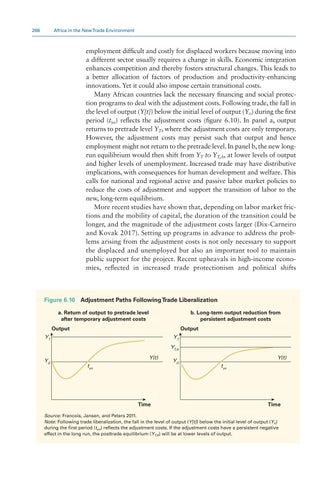268 Africa in the New Trade Environment
employment difficult and costly for displaced workers because moving into a different sector usually requires a change in skills. Economic integration enhances competition and thereby fosters structural changes. This leads to a better allocation of factors of production and productivity-enhancing innovations. Yet it could also impose certain transitional costs. Many African countries lack the necessary financing and social protection programs to deal with the adjustment costs. Following trade, the fall in the level of output (Y[t]) below the initial level of output (Yo) during the first period (tyo) reflects the adjustment costs (figure 6.10). In panel a, output returns to pretrade level YT, where the adjustment costs are only temporary. However, the adjustment costs may persist such that output and hence employment might not return to the pretrade level. In panel b, the new longrun equilibrium would then shift from YT to YT,A, at lower levels of output and higher levels of unemployment. Increased trade may have distributive implications, with consequences for human development and welfare. This calls for national and regional active and passive labor market policies to reduce the costs of adjustment and support the transition of labor to the new, long-term equilibrium. More recent studies have shown that, depending on labor market frictions and the mobility of capital, the duration of the transition could be longer, and the magnitude of the adjustment costs larger (Dix-Carneiro and Kovak 2017). Setting up programs in advance to address the problems arising from the adjustment costs is not only necessary to support the displaced and unemployed but also an important tool to maintain public support for the project. Recent upheavals in high-income economies, reflected in increased trade protectionism and political shifts
Figure 6.10 Adjustment Paths Following Trade Liberalization a. Return of output to pretrade level after temporary adjustment costs
b. Long-term output reduction from persistent adjustment costs
Output
Output
YT
YT YT,A
YO
Y(t) tyo
Time
YO
Y(t) tyo
Time
Source: Francois, Jansen, and Peters 2011. Note: Following trade liberalization, the fall in the level of output (Y[t]) below the initial level of output (Yo) during the first period (tyo) reflects the adjustment costs. If the adjustment costs have a persistent negative effect in the long run, the posttrade equilibrium (YT,A) will be at lower levels of output.


